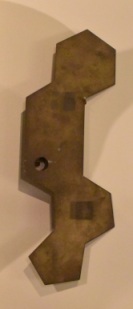Biographies for Kids
James Watson and Francis Crick
Back to Biographies

DNA by Jerome Walker and Dennis Myts
- Occupation: Molecular biologists
- Born:
Crick: June 8, 1916
Watson: April 6, 1928 - Died:
Crick: July 28, 2004
Watson: Still alive - Best known for: Discovering the structure of DNA
James Watson
James Watson was born on April 6, 1928 in Chicago, Illinois. He was a very intelligent child. He graduated high school early and attended the University of Chicago at the age of fifteen. James loved birds and initially studied ornithology (the study of birds) at college. He later changed his specialty to genetics. In 1950, at the age of 22, Watson received his PhD in zoology from the University of Indiana.

James D. Watson.
Source: National Institutes of Health
Watson (along with Francis Crick, Rosalind Franklin, and Maurice Wilkins) was awarded the Nobel Prize in Physiology or Medicine in 1962 for the discovery of the DNA structure. He continued his research into genetics writing several textbooks as well as the bestselling book The Double Helix which chronicled the famous discovery.
Watson later served as director of the Cold Spring Harbor Lab in New York where he led groundbreaking research into cancer. He also helped to form the Human Genome Project which mapped out the human genetic sequence.
Francis Crick
Francis Crick was born in Weston Favell, England on June 8, 1916. His father was a shoemaker, but Francis soon found a love for learning and science. He did well in school and attended the University College London. Crick had won several awards for his research when he met James Watson at the Cavendish Laboratory in Cambridge, England. They soon made their famous discovery of the DNA double helix in 1953.
After making the discovery and winning the Nobel Prize in 1962, Crick continued his research into genetics at Cambridge. He later worked as a research professor at the Salk Institute in California for many years. Crick died of colon cancer on July 28, 2004.
Discovering the Structure of DNA
In the early 1950s, scientists had learned a lot about genetics, but they still didn't understand the structure of the DNA molecule. Scientists needed to understand the structure of DNA in order to fully understand genetics. The Cavendish Laboratory had put together a team to try and solve the problem before an American team led by the famous biochemist Linus Pauling could. It became a race to see who could figure it out first!
When Crick and Watson met at Cambridge they quickly learned that they had the same passion for solving the DNA structure. They both had similar ideas as well on how the problem could be solved. Despite having very different personalities, they became good friends and respected each other's work.

DNA model template used by Crick and Watson.
Source: Smithsonian. Photo by Ducksters.
In 1953, Crick and Watson were able to put together an accurate model of the DNA structure. The model used a twisting "double helix" shape. This model would help scientists throughout the world in learning more about genetics.
Interesting Facts about James Watson and Francis Crick
- When Watson was a kid, he appeared as a contestant on the radio show Quiz Kids.
- Watson became the second person to make his genetic sequence available online.
- Both Crick and Watson had strong personalities. Crick was outgoing and boisterous. Watson was considered more reserved, but arrogant.
- Crick and Watson used Rosalind Franklin's images of the DNA molecule without her permission.
- Both Watson and Crick were inspired by the book What Is Life? by Austrian physicist Erwin Schrodinger.
Take a ten question quiz about this page.
Back to Biographies >> Inventors and Scientists
Other Inventors and Scientists:
Works Cited


